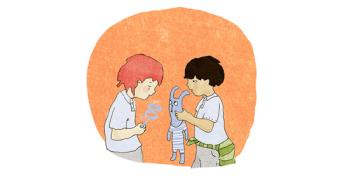
Family courts are misunderstanding and misusing research around how children form close relationships with their caregivers, say an international group of experts.
Family courts are misunderstanding and misusing research around how children form close relationships with their caregivers, say an international group of experts.
The decisions reached by family courts can have a major impact on a child’s life, but as we’ve seen, these decisions may be based on incorrect understanding and assumptions
Robbie Duschinsky
Seventy experts from across the globe argue that widespread misunderstandings around attachment research have hampered its accurate implementation, with potentially negative consequences for decisions in family courts.
In response, they have published an international consensus statement in Attachment & Human Development that aims “to counter misinformation and help steer family court applications of attachment theory in a supportive, evidence-based direction on matters related to child protection and custody decisions”.
In the statement, the group sets out three principles from attachment research which they say should guide decision-making: the child’s need for familiar, non-abusive caregivers; the value of continuity of good-enough care; and the benefits of networks of familiar relationships.
Attachment research investigates the strong affectional bonds – ‘attachments’ – that individuals form to others in order to achieve comfort and protection. Children are born with a predisposition to develop these bonds with ‘attachment figures’ in their lives. This often includes the child’s parents, but many children develop attachment relationships with additional caregivers, such as grandparents. Children wish to turn to their attachment figures when upset.
The quality of an attachment relationship – how readily a child will turn to their caregiver and accept comfort – is indicated by behaviour suggestive of whether or not they expect their attachment figures to respond sensitively to their signals in times of need. Indeed, the most important predictor of children’s attachment quality is caregiver ‘sensitivity’: the ability to perceive, interpret and respond in a timely manner and appropriately to children’s signals.
Attachment research is applied in many settings, including in family court decision-making regarding child custody and child protection. Court practice needs to follow the best interests of the child, but this can be difficult to determine. There is an increasing focus on the interactions and relationships between children and their caregivers, which in turn has led to interest in using attachment theory and measures to help guide decision-making.
Dr Robbie Duschinsky from the University of Cambridge, said: “The decisions reached by family courts can have a major impact on a child’s life, but as we’ve seen, these decisions may be based on incorrect understanding and assumptions. By outlining potential issues and presenting principles to guide the decision-making process, we hope to better inform and hence empower courts to act in a child’s best interests.”
One example is the mistaken assumption that attachment quality equals relationship quality, and that it is possible to judge attachment quality by looking at isolated behaviours. In fact, there are many other important aspects of child-caregiver relationships, such as play, supervision and teaching, and specific behaviours such as crying can depend on largely constitutional factors such as temperament.
There are also misunderstandings regarding the importance of developing attachment to one particular caregiver rather than to more than one, with the theory misinterpreted as placing an emphasis on one ‘psychological parent’, typically the mother. In this line of reasoning, it is often assumed that an attachment relationship with one person is at the expense of other attachment relationships, and that best-interest decisions should maximise the likelihood of secure attachment with one primary caregiver. However, children can develop and maintain secure attachment relationships to multiple caregivers simultaneously, and a network of attachment relationships may well constitute a protective factor in child development.
In other cases, attachment theory has been held to categorically prescribe joint physical custody, with equal time allocation regardless of child age, including overnights and transitions between family homes every day or every other day. Yet, there is a notable scarcity of empirical research on attachment in relation to child custody, time allocation, and overnight arrangements.
Dr Tommie Forslund from Stockholm University said: “Misunderstandings can have important consequences for children and their caregivers. In some cases, they can lead to an ill-informed dismissal of the relevance of attachment by court professionals or, conversely, to the overuse of attachment ideas and measures, with practice unmoored from evidence.
“We need to make sure that courts are aware of the limits of current understanding as well as the nuances of attachment theory and research before seeking to apply it to their decision-making.”
The researchers have also advised caution in using assessments of attachment quality in the family courts.
Professor Pehr Granqvist from Stockholm University added: “Courts need to bear in mind that while assessments of attachment quality may be suitable for helping target supportive interventions, there are different opinions even among those of us who specialise in attachment research regarding the potential usefulness of these assessments when it comes to decision-making regarding child protection.
“Validated in group-level research, attachment measures have insufficient precision for individual level prediction. If used at all, assessments of attachment quality should never be used in isolation but only as part of a larger assessment battery that assigns more weight to direct assessments of caregiving behaviour. Importantly, attachment assessments must only be used by formally trained observers who follow standardised protocols.”
The experts propose three fundamental principles, based on more than half a century of research, which they argue can be used as a basis for court practitioners:
- The need for familiar, non-abusive caregivers – For child protection practice, for example, this implies that all non-abusive and non-neglecting family-based care is likely to be better than institutional care.
- The value of continuity of good-enough care – ‘Good-enough’ care signifies an adequate level of meeting the child’s needs over time. The group urges family courts to examine and support caregivers’ abilities to provide ‘good-enough’ caregiving, rather than placing children in out-of-home custody with the hope of ‘optimal’ care. Major separations from caregivers constitute risk factors in child development that should be prevented whenever possible.
- The benefits of networks of attachment relationships – Decision-making concerning child custody should assign weight to supporting children’s ability to develop and maintain attachment relationships with both their caregivers, except when there is threat to the child’s welfare and safety or one of the parents wants to ‘opt out’.
Reference
Attachment Goes to Court: Child Protection and Custody Issues. Attachment & Human Development; 11 Jan 2021; DOI: 10.1080/14616734.2020.1840762

The text in this work is licensed under a Creative Commons Attribution 4.0 International License. Images, including our videos, are Copyright ©University of Cambridge and licensors/contributors as identified. All rights reserved. We make our image and video content available in a number of ways – as here, on our main website under its Terms and conditions, and on a range of channels including social media that permit your use and sharing of our content under their respective Terms.




